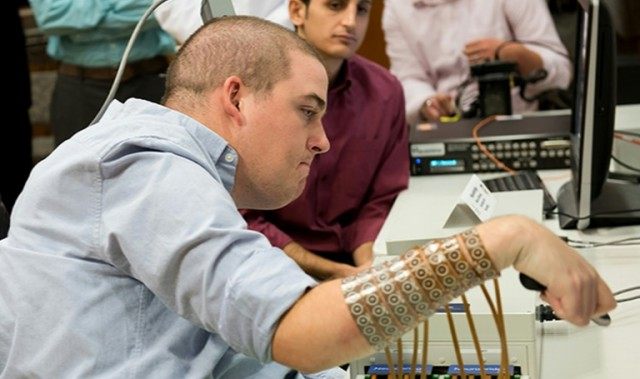Paris (AFP) – Six years after being paralysed from the chest down, an American man can use his right hand to stir coffee and swipe a credit card, a groundbreaking study reported on Wednesday.
The unprecedented feat was made possible by computer software replacing the damaged spinal cord as the communication highway between Ian Burkhart’s brain and his hand muscles.
“This is the first time a completely paralysed person has regained movement just by using their own thoughts,” said researcher Chad Bouton of the Feinstein Institute for Medical Research in Manhasset, New York.
Burkhart, a 24-year-old from Ohio, has a pea-sized chip in his head to read his brain signals, which are then deciphered by a computer and rerouted to the hand, wrist and finger muscles.
The muscles receive their instructions from an electrode sleeve worn on the right forearm — with which Burkhart can now also swipe a credit card, pick up a spoon, hold a phone to his ear and play the cords of a guitar video game.
The US-based researchers hope their work, still in an early phase, will one day allow paralysed people to feed and dress themselves.
Their device, called NeuroLife, reroutes messages from the brain to the muscles, bypassing the spinal cord.
Two years ago, they reported a major breakthrough when Burkhart was able to open and close his hand.
With a lot more training, he has since refined his skills and can now grip a “stir stick” with his fingertips, and use it.
Burkhart broke his neck in a holiday diving accident aged 19 and was left quadriplegic — meaning his arms and legs are paralysed.
“Doctors told me I’d broken my neck and that most likely I’d be able to move my shoulders around, but nothing else for the rest of my life,” he told journalists in a teleconference ahead of the report’s release.
– ‘Now I can do it’ –
He volunteered for the trial, Burkhart said, because he wanted to help people like himself regain their independence.
“Just not being able to use your hands does limit you quite a bit,” he said. “I have to rely on other people for things.”
Burkhart underwent surgery to have the chip implanted in the brain’s motor cortex area, which controls movement.
The chip was attached on top of the skull to a “connector” linking it to a computer which Burkhart “trained” to read his mind and decode which movements he wanted to execute.
The command to open, clench or pinch is then relayed to an electrode sleeve on Burkhart’s right arm.
“When we first hooked everything up… it was a big shot,” he recounted.
“I hadn’t moved in about three-and-a-half years at that point. Now it’s something that’s just so fluid it’s kind of like it was before I had my injury.
“I just think about what I want to do, and now I can do it.”
Some of the functions he has relearnt have the potential of changing his daily life for the better. But for now, he can only do them in the lab.
The researchers said they hope to improve the technology to help not only people with spinal cord injuries, but also those who suffered a stroke or traumatic brain injury.
“Maybe in a few years from now we can have a wireless system that allows a patient like Ian to be able to move his hand and his arm… without cables to connect,” said Ali Rezai of Ohio State University.
“This becomes more streamlined hopefully over time, maybe integrated into your cellphone… communicating with your sleeve.”
Several teams worldwide are researching ways to bypass a damaged spinal cord, many focusing on using the mind to control robotic limbs or exoskeletons.
But the holy grail is to allow quadriplegics to use their own limbs, limiting the need for surgery and prosthetics.
“If all the work we’ve been doing can help anybody get more independence back, I mean that’s great,” said Burkhart.
“I really cherish the independence I had before my injury, so if you can give someone that ability back, it’s huge.”
A video explaining the findings can be viewed at: https://www.youtube.com/watch?v=60fAjaRfwnU

COMMENTS
Please let us know if you're having issues with commenting.